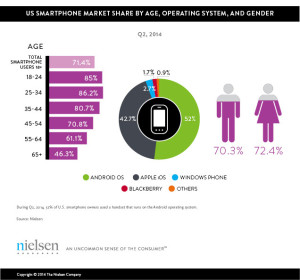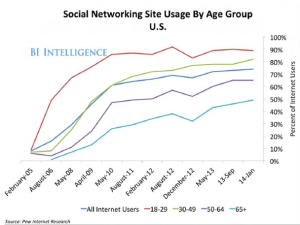Growth of mobile among millennials, programmatic advertising, social media’s move into the mainstream, the problem with attribution in advertising, and more are among the topics covered in this month’s installment of TFP’s Media Metrics roundup.
We compile excerpts from some of the key stories covering issues affecting the publishing and media industries each month to help you keep up with current media industry trends and prepare for changes that are just around the corner. Here are our top picks.
Millennials Are the Largest Group of Smartphone Owners, and Adoption Is Still Growing (TechCrunch)
and Adoption Is Still Growing (TechCrunch)
- According to a Q2 Nielsen report, millennials are the largest group of mobile device owners: 85% of people 18 to 24 years old own a smartphone, as do 86% of those 25 to 34 years old. That reflects an increase from 77% and 80%, respectively, over the same period last year.
- It also said that 52% of U.S. smartphones run Android and 42.7% run Apple iOS, while other operating systems, including Windows Phone and Blackberry, account for the remainder.
- In an earlier related report, the research firm found that those 25 to 44 years old use 29 apps per month on average, the most of any age group. But it noted that users 18 to 24 years old spend the most time on their smartphones: just over 37 hours per month on average.
Study: Advertisers Don’t Get Programmatic (Media Life Magazine)
- A Forrester survey of client-side marketers revealed that just 23% of respondents understand programmatic advertising and have used it. Further, 29% have heard the term but don’t know what it means; 26% understand the concept but not how to apply it; 10% understand it but haven’t used it; and the remaining 12% have never heard of programmatic advertising at all.
- The top reasons for considering or expanding programmatic advertising are cost efficiencies (39%), greater control (32%), and full ownership of marketing data (25%).
Social Networking Has Officially Gone Mainstream (SocialTimes)
- While millennials are still ahead of earlier generations when it comes to social network use, more than 50% of people over 65 use social media sites, a BI Intelligence study found.
- The majority of Facebook, Twitter, LinkedIn, Pinterest and Google+ users are now in their late 20s and early 30s vs. teens to mid-20s.
- In terms of gender differences, women are now only 4% more likely than men to use social sites compared with 9% a year ago. However, women are still 10% more likely to use Facebook, and the site also remains popular among younger users, the report said.
- Messaging apps like Snapchat are still the domain of young users, but only 25% of messaging app users are in the 15- to 24-years-old age group.
Forrester: Attribution Still Holding Back Spending in Mobile Advertising (Street Fight Magazine)
- A Forrester study found that only 13% of marketers said they feel very confident that they can effectively measure the results of cross-channel advertising, and only 18% said they are very confident that they are able to measure their return on mobile.
- To measure mobile advertising campaigns, 36% of study participants said they look at click throughs, 36% use website hits/traffic sources, 31% take into account social interactions, 30% use post-click engagement, and 29% measure brand awareness lift.
- 93% of study participants said if they could better measure their mobile advertising performance, they would launch more cross-channel campaigns.
Nielsen Finds Older Adults Are Embracing Digital Video (The New York Times)
- According to a Nielsen report, people in the 50- to 64-years-old age group viewed an average of 19 minutes a day of digital video in the second quarter of 2014. That’s an increase from 11 minutes a day in the same period last year.
- The amount of time people in that same age group spent in front of televisions in that period fell by 6 minutes, to 6 hours and 12 minutes a day. Overall, the amount of time adults spent viewing television decreased 2%, the report said. However, viewing on computers and smartphones led to an overall 4% increase in media consumption.
- Children 12 to 17 watched television the least amount of time in any age group: about 2 hours and 43 minutes a day.
- The report also showed a significant increase in smartphone use during the quarter, with adults spending 1 hour and 25 minutes on their smartphones, compared with just 48 minutes during the same period two years ago.
How Tablet Advertising Differs From Mobile Advertising: Key Metrics (TabTimes)
- Data from Medialets shows that tablets get only 12% of all ad impressions served on mobile devices.
- The average ad click-through rate (CTR) is 0.59% on tablets compared with 0.41% on mobile devices.
- Static ads are clicked 53% more often on tablets than on phones (0.81% vs. 0.53%, respectively); full-screen static ads are clicked 6 times more on tablets than on smartphones.
- The report also showed a significant increase in smartphone use during the quarter, with adults spending 1 hour and 25 minutes on their smartphones, compared with just 48 minutes during the same period two years ago.
- Expandable ads don’t do well on tablets, with an expansion rate that’s 65% lower than with smartphones.
Social Media and the ‘Spiral of Silence’ (Pew Research Center)
- In a study about the willingness of Americans to discuss controversial topics on social media, using Edward Snowden’s 2013 revelations about NSA surveillance as the focus issue, 86% of participants said they would talk about the subject in face-to-face settings while only 42% said they would post their opinions about it on Facebook or Twitter.
- Of the 14% of study participants who said they would not express their thoughts on the topic in person, almost none (0.3%) said they would do so via social media.
- Facebook users who believed that members of their network agreed with their position on the Snowden-NSA issue were about twice as likely to join a Facebook discussion on the subject.
- The study also showed that social media was not a significant source of such information for study participants: 58% got at least some information from TV or radio, 34% from online sources other than social media, 31% from friends or family, 19% from print newspapers, 15% from Facebook, and 3% from Twitter.
Paid Search Spend Rose 21 Percent YoY In Q2, With Mobile Up 98 Percent (Search Engine Land)
- According to Covario’s latest quarterly report, overall search spend increased 21% in the second quarter year over year and 2% over the first quarter.
- Mobile search spend jumped 98% compared with last year and 6% quarter over quarter.
- However, while mobile impressions, clicks and costs saw second-quarter increases in the double digits, mobile CPCs were down 43% compared with desktop clicks. Growth fell 6% compared with the first quarter and was flat year over year.
- Tablets accounted for 62% of mobile spend in the second quarter, while smartphones were the remaining 38%.
Study: Shorter Is Better for Mobile Video Ads (Media Life Magazine)
- While 10-second mobile video ads are the most effective, they make up only about 3% of mobile ad budgets, according to a study done in the U.K.
- Completion and click-through rates in the study indicate that 10-second ads are 65% more effective than the average video ad.
- When it comes to entertainment brands, 20- and 30-second ads account for 75% of mobile ad spending. However, on average, they are 27% and 13% less effective than 10-second ads, respectively.
Targeted Display to Drive Online Ad Growth (NetNewsCheck)
- A local advertising forecast from Borrell Associates’ projects that online advertising will grow 44% through 2015, with targeted display ads driving that increase.
- It said some 23% of all digital spending has ended up on mobile devices this year, and almost all advertising (92%) will be on mobile devices by 2019.
- The report also projects that promotions will increase 20% in 2015.
Media Metrics is a monthly feature from Technology for Publishing, aimed at keeping you armed with the latest industry data. If you’d like to share something you’ve read, drop us a note. And keep up with the latest industry news coverage by signing up for our This Week in Publishing emails or our monthly Publishing Trends newsletter
Posted by: Margot Knorr Mancini


